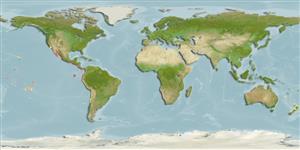Environment: milieu / climate zone / depth range / distribution range
Ecologie
marien benthopelagisch; diepte 0 - 50 m (Ref. 9283). Subtropical; 34°N - 18°S, 118°W - 70°W
Eastern Pacific: Redondo Beach in southern California, USA to Peru; rare north of Baja California, Mexico.
Grootte / Gewicht / Leeftijd
Maturity: Lm ? range ? - ? cm
Max length : 40.0 cm TL mannelijk / geslacht onbekend; (Ref. 55763); common length : 24.0 cm FL mannelijk / geslacht onbekend; (Ref. 9283)
Body very short, deep, and compressed; lower branch of first gill arch with 30 to 35 gill rakers; dorsal fin with 8 spines followed by another spine and 21 to 24 soft rays (VIII1, 21-24); anterior lobe of second dorsal and anal fins not elongated in adults; anterior dorsal spines prolonged in juveniles; body scaleless; lateral line scutes very weak and poorly differentiated; body silvery to gold with metallic blue highlights; juveniles silvery, with a dark oval stain on the straight part of the lateral line (ref. 55763).
Adults are found in coastal waters up to at least 50 m depth (Ref. 9283). They generally form schools near the bottom (Ref. 9283). Juveniles are encountered near the surface (Ref. 9283). They feed on small fishes and crustaceans (Ref. 9283). Marketed fresh and salted or dried (Ref. 9283).
Levenscyclus en paargedrag
Maturiteit | Voortplanting | Paaien | Eieren | Fecunditeit | Larven
Eschmeyer, W.N., E.S. Herald and H. Hammann, 1983. A field guide to Pacific coast fishes of North America. Boston (MA, USA): Houghton Mifflin Company. xii+336 p. (Ref. 2850)
Status op de Rode Lijst van het IUCN (Ref. 130435)
Gevaar voor de mens
Harmless
Gebruik door de mens
Visserij: van minder commercieel belang
Meer informatie
ReferentiesAquacultuurAquacultuurprofielKweeklijnenGeneticaElectrophoresesErfelijkheidZiektesVerwerkingNutrientsMassaconversie
Tools
Speciale rapporten
Download XML
Internetbronnen
Estimates based on models
Preferred temperature (Ref.
123201): 20.5 - 28.4, mean 25.1 °C (based on 68 cells).
Fylogenetische diversiteitsindex (Ref.
82804): PD
50 = 0.5039 [Uniqueness, from 0.5 = low to 2.0 = high].
Bayesian length-weight: a=0.01738 (0.01092 - 0.02766), b=2.83 (2.70 - 2.96), in cm total length, based on LWR estimates for this species & (Sub)family-body (Ref.
93245).
Trofisch niveau (Ref.
69278): 4.3 ±0.5 se; based on diet studies.
Weerstandsvermogen (Ref.
120179): Hoog, minimale populatieverdubbelingstijd minder dan 15 maanden (Preliminary K or Fecundity.).
Fishing Vulnerability (Ref.
59153): Low to moderate vulnerability (30 of 100).
Nutrients (Ref.
124155): Calcium = 78.7 [38.4, 176.8] mg/100g; Iron = 1.24 [0.61, 2.65] mg/100g; Protein = 17.8 [15.7, 20.2] %; Omega3 = 0.296 [0.153, 0.593] g/100g; Selenium = 25.7 [11.0, 58.5] μg/100g; VitaminA = 17.2 [4.4, 65.3] μg/100g; Zinc = 0.553 [0.352, 0.864] mg/100g (wet weight);
